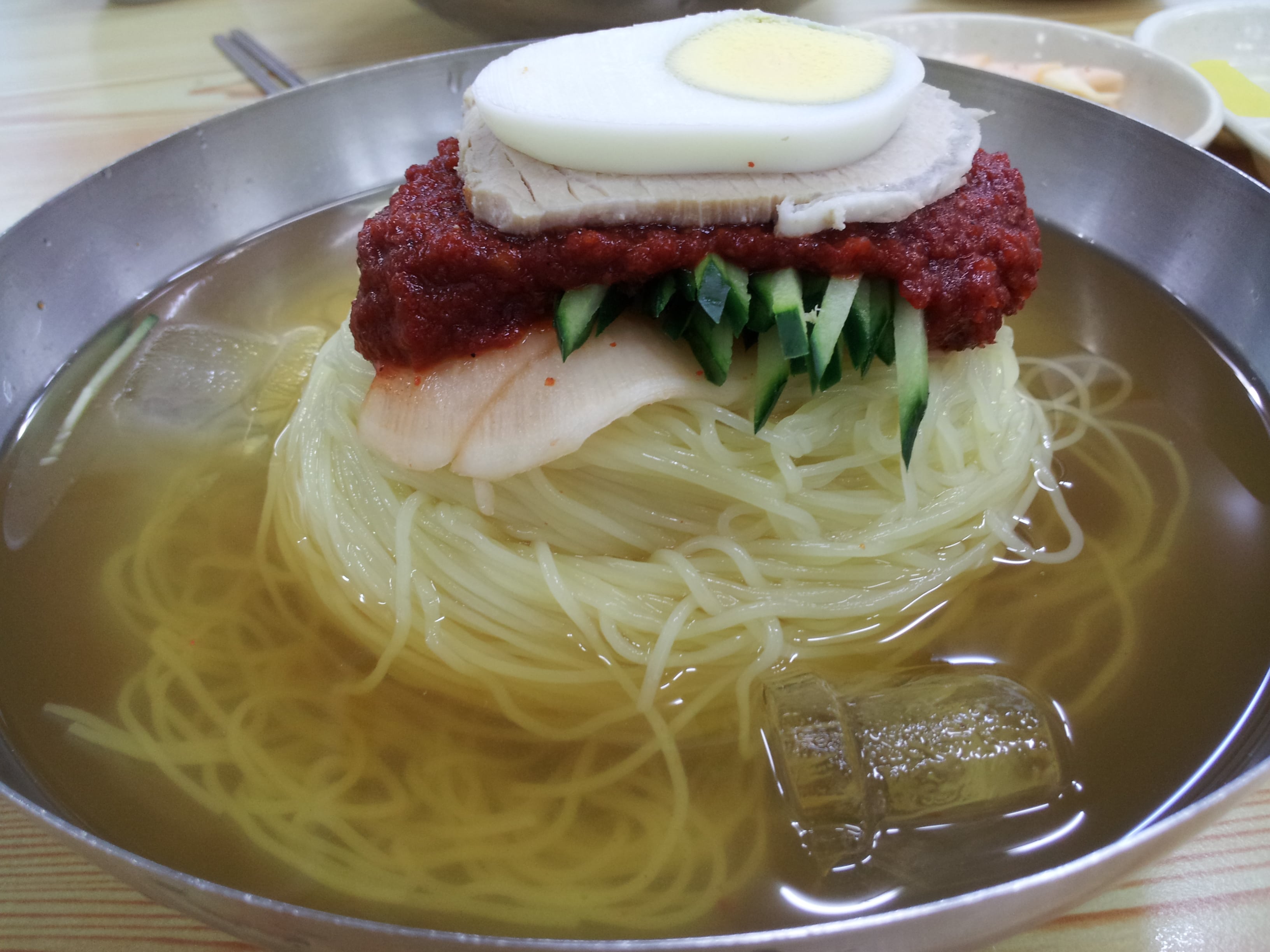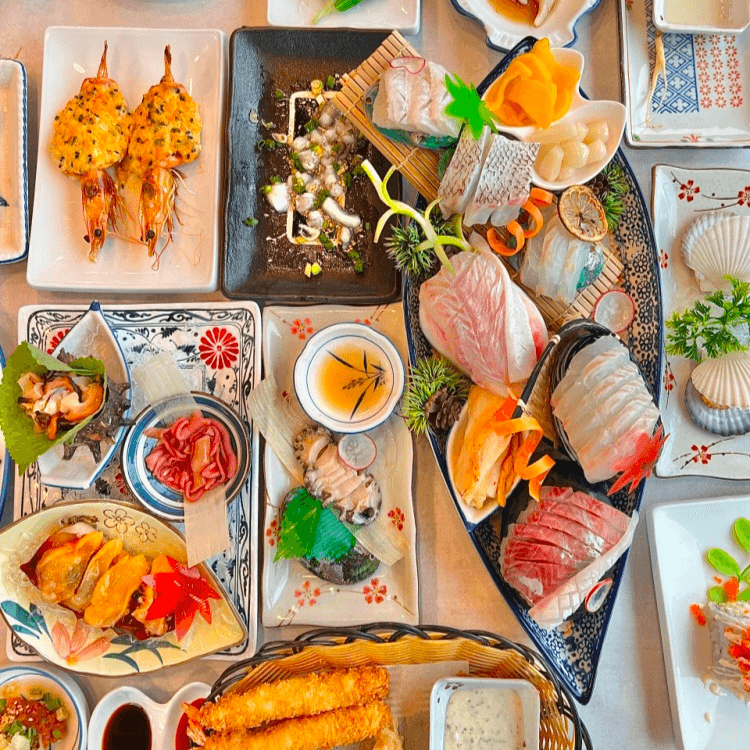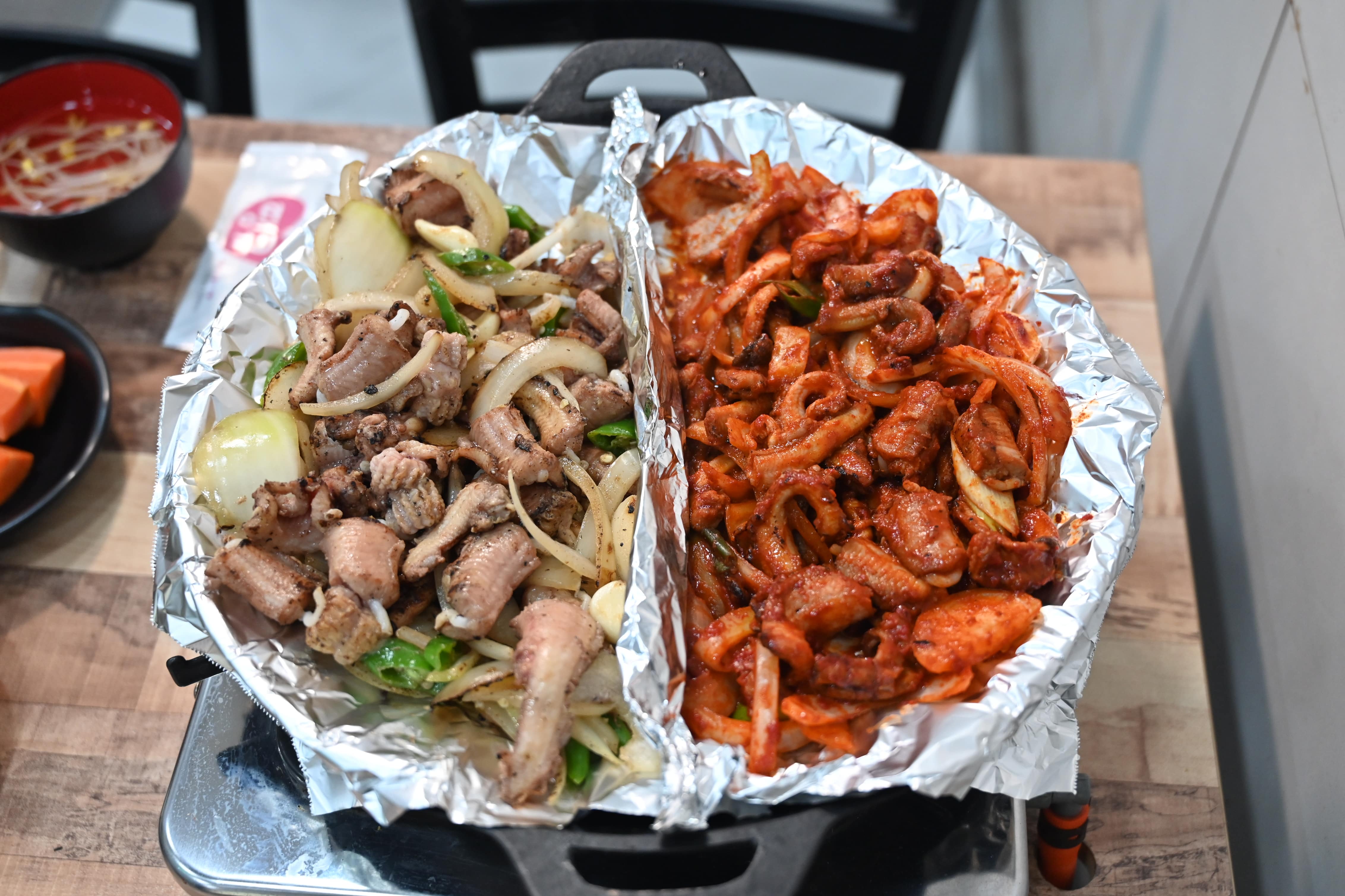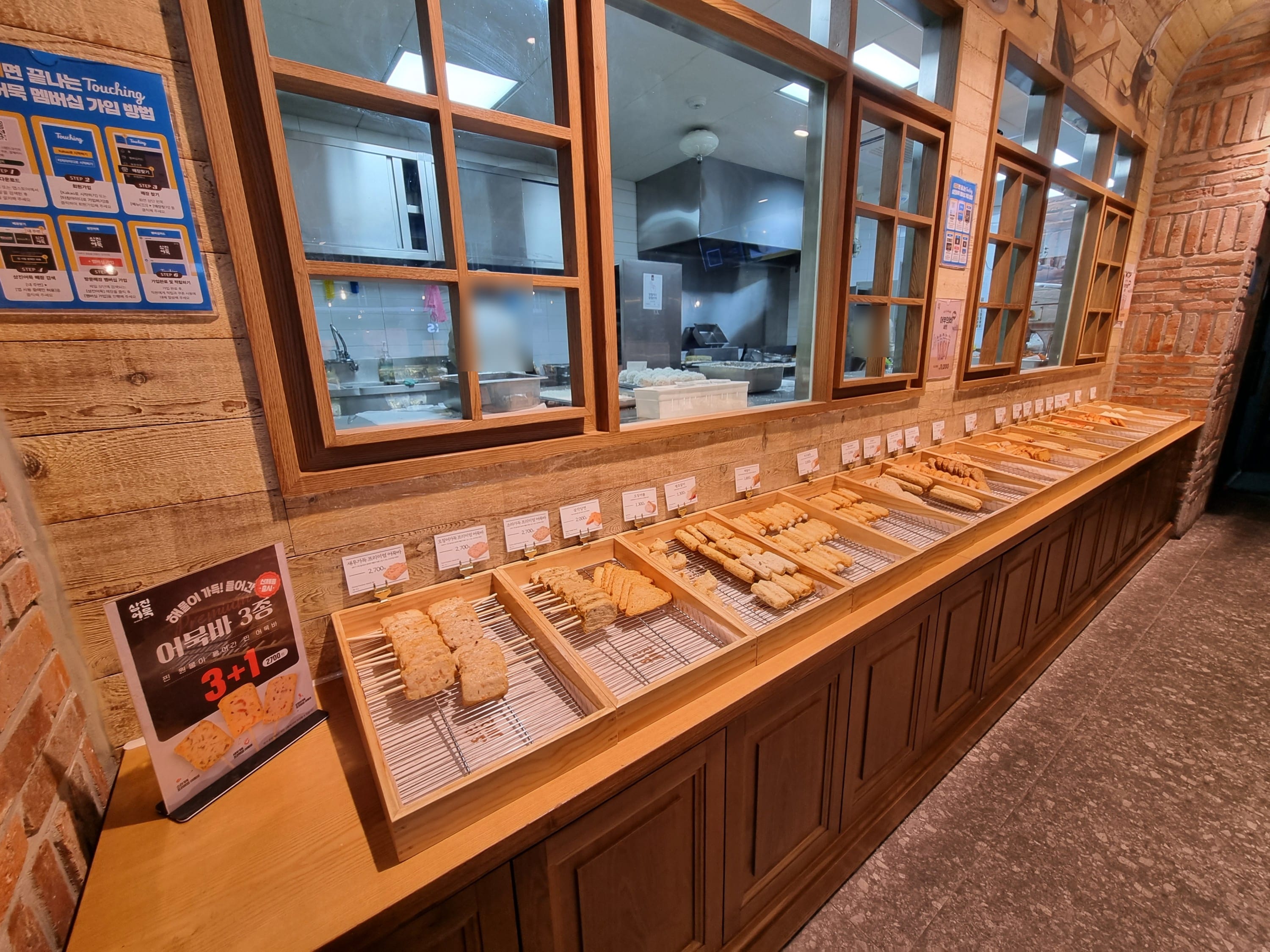Busan's Best Eats: What and Where to Eat
6 things to eat in Busan and where to go
Busan is a city in South Korea known for its rich culture, beautiful beaches, and delicious food. The city's cuisine is a blend of traditional Korean dishes and unique seafood specialties that are a must-try for any food lover. In this guide, we'll explore some of Busan's best eats and where to find them.
Dwaeji Gukbap (Pork Soup with Rice)
You can’t visit Busan without having a dwaeji gukbap, which is pork soup with rice, one of the most famous dishes in Busan. The dish is simple — it is made by boiling pork bone for a long duration until the soup becomes white and creamy. The soup is creamy and fatty, but it doesn’t get too overwhelming, making it perfect for a hearty meal. When served, you will be given a bowl of rice, and people typically eat it by mixing the cooked rice with the soup. It is also up to you to season the soup based on your personal preference, and some common garnishes that people add include saeujeot (salted shrimp), buchumuchim (seasoned garlic chives), or kkakdugi (diced radish kimchi).

You can find some of the best dwaeji gukbap in Busan at:
Yeongjin Dwaeji Gukbap (Naver Map | Google Map)
When you talk about Dwaeji Gukbap in Busan, Yeongjin Dwaeji Gukbap (영진돼지국밥) is a name that will almost always be mentioned. They also have many branches across Busan, but the main branch that most people visit is the one at Saha-gu. They are best known for their huge servings of the creamy soup. Apart from the soup, their _Suyuk _ (boiled pork) is also a favourite with many. The soup are priced at 9,000KRW each.
🕤 Opening Hours: 9.30am - 9.30pm, break time from 3.00pm - 5.00pm
Subyeon Choego Dwaeji Gukbap (Naver Map | Google Map)
Subyeon Choego Dwaeji Gukbap (수변최고돼지국밥) is one of the most popular Dwaeji Gukbap restaurants in Busan. They have four branches across Busan, with the main branch at Suyeong-gu that is open 24 hours. They have several variations of the soup that you can choose from — whether you just want the meat, pig inert, soondae (blood sausage), or a combination of these. All their soup is priced at 9,000 KRW.
🕤 Opening hours: 24 hours
Geukdong Dwaeji Gukbap (Naver Map | Google Map)
Geukdong Dwaeji Gukbap (극동돼지국밥) is one of the most popular options if you are looking for Dwaeji Gukbap near Haeundae. Queues form really quickly and the store is almost always crowded. Take note though that as compared to the usual creamy soup of Dwaeji Gukbap, their version of the soup has a much clearer and lighter soup base, and the taste of the pork isn’t that strong. Their meats are also sliced into smaller pieces than the typical Dwaeji Gukbap. So if you are looking for something lighter after a night’s out at Haeundae, this could be a great choice. But of course, if you are looking for something more flavourful, then you may want to consider other options. Prices are also slightly more expensive at 10,000KRW.
🕤 Opening Hours: 8am - 9pm daily, break time from 3.30pm - 5pm on Monday to Thursday; last order at 8.30pm
Milmyeon (Wheat Noodles)
If you have heard of the Korean dish Naengmyeon, milmyeon is a variation of it that is made using wheat noodles. Summer in Busan can get very intense, and Milmyeon is a perfect choice of a meal to help cool you down. Milmyeon is typically served in two manners - mulmilmyeon, where the noodles are served in a refreshing cold broth, or bibimmilmyeon, where the wheat noodles are tossed up in spicy sauce (think bibimbap, except the rice is replaced with milmyeon). *Mulmilmyeon *is generally regarded as a rather acquired taste so if you are looking for something safer, consider going for the bibimmilmyeon. But if you are up for something new and visiting Busan in summer, we strongly recommend you try the *mulmilmyeon. *Be sure to add some vinegar and mustard (that the restaurants will provide) to your mulmilmyeon for an additional boost of flavours.

For some of the best milmyeon in Busan, check out:
Gukjae Milmyeon (Naver Map | Google Map)
Gukjae Milmyeon is known as one of the top 3 milmyeon places in Busan. They are a milmyeon specialty restaurant with only 2 items on their menu - the mulmilmyeon and the bibimmilmyeon, with the option of small (9,000KRW) or large (10,000KRW) serving sizes. One of the biggest reason for their popularity is their noodles, which are chewy and firm. The broth of the mulmilmyeon could be considered bland to some, but that’s nothing some vinegar and mustard can’t fix.
🕤 Opening Hours: 10am - 8pm daily
Haeundae Gaya Milmyeon (Naver Map | Google Map)
What better way to cool down after a day out at the beach than to have a refreshing bowl of milmyeon. The Haeundae Gaya Milmyeon is one of the most popular restaurants near the Haeundae beach — be prepared to queue, though the crowds clear out rather quickly. They only have three items on their menu: milmyeon (9,000KRW), bibimmyeon(9,000KRW), and mandu (5,000KRW).
🕤 Opening Hours: 10am - 9pm daily
Choryang Milmyeon (Naver Map | Google Map)
Choryang Milmyeon is another restaurant that is listed as one of the top three in Busan. While its mulmilmyeon has received mixed reviews, their bibimmilmyeon has generally been very well received. The prices at Choryang Milmyeon is also relatively cheaper, where you can get a small serving at 6,000KRW and a large one at 6,500KRW. They also have Mandu and _Seafood Kalguksu _ (Seafood Noodles) on their menu, both of which also worth trying while you are there.
🕤 Opening Hours: 10am - 10pm daily
Saengseonhoe (Sliced Raw Fish)
When we think of sliced raw fish, what comes to mind is usually Japan’s fresh sashimi. But did you know that Korea also does their sliced raw fish pretty well? If you are in Busan especially, definitely do try out their sliced raw fish. Being a port city, the seafood in Busan is very fresh and at very affordable prices. Saengseonhoe (or sliced raw fish) is prepared fresh upon order so it tastes sweet and chewy. It is often advised to avoid raw seafood during summer as the heat could cause the raw fish to go bad quickly because of the heat, but as long as you don’t leave the fish out for too long before eating, you should be fine.

Some places you can go for sliced raw fish include:
Millak Hoe Centre (Naver Map | Google Map)
For some of the freshest saengseonhoe, definitely head to Millak Hoe Centre, a seafood market located at Gwangalli Beach. At the restaurants at Millak Hoe Centre, you will be able to choose your own fish and the restaurant will prepare it for you on the spot. At Millak Hoe Centre, you can trust that the fish will be fresh — but don’t expect amazing service or a very comfortable dining environment!
🕤 Opening Hours: Varies for individual shops
GwangAn Dachi (Naver Map | Google Map)
Another seafood restaurant located near Gwangalli Beach, the GwangAn Dachi (광안다찌) is one of the most highly rated seafood restaurants in the area. Not only is the food fresh and good, you will also get great views of the Gwangan Bridge, alongside amazing service. As it is away from the bustle of the Millak Hoe Centre, you will also get a calmer atmosphere at this restaurant. A one-person set here costs 49,000KRW, which is cheaper than most other restaurants in the same area.
Take note though that if you would like to dine at GwangAn Dachi, reservations are required. You will need a Korean number to make a reservation, but you could perhaps try sliding into their DM on Instagram to see if they take reservations via Instagram too.
🕤 Opening Hours: 12pm - 11pm daily, break time from 3pm - 4.30pm; last order at 8.30pm
Gomjangeogui (Grilled Eel)
Gomjangeogui is another seafood delicacy that is popular in Busan. It is made by grilling freshwater eel, which is marinated in a savory and slightly sweet sauce. The eel is then grilled over an open flame until it's tender and crispy on the outside, yet soft and succulent on the inside. Depending on one's preference, it can be enjoyed with just salt or yangnyeom (spicy sauce).

Gyeongbuksan Ggomjangeo (Naver Map | Google Map)
The Gyeongbuksan ggomjangeo (경북산꼼장어) is a small, cozy restaurant in Choryang, Busan. A small portion of the eel costs 45,000KRW; and if you want to try both the salted flavour and yangnyeom flavour, there is the option of going for the half-half at 65,000KRW; the half-half portion is good for 3 to 4 pax. Their eels are known to be well-seasoned and without the fishy taste. For the best experience, definitely do order the fried rice (at 2,500KRW) at the end of your meal.
🕤 Opening Hours: 1pm - 12.30am from Monday - Thursday; 11am - 1.30am from Friday - Sunday
Gijangjonggajip Gomjangeo (Naver Map | Google Map)
This is another fairly popular grilled eel specialty restaurant, best rated for delicious and fresh food as well as good service. They are best known for their salted grilled eel at 30,000KRW per person. They also have a set that includes samgyeopsal (pork belly) together with the yangnyeom grilled eel.
🕤 Opening Hours: 11am - 9.30pm daily, break time from 3.30pm - 4pm, last order at 8.30pm
Dongnae Pajeon (Green Onion Pancake)
Those familiar with Korean food should already know Pajeon (pancake), but some of the most common pajeon that you might have tried would be the kimchijeon (kimchi pancake) or haemuljeon (seafood pajeon). If you are in Busan, forget those and go for the Dongnae pajeon(green onion pancake). The rice flour batter is mixed with green onions, fresh seafood, beef, and chives, before being pan fried till it becomes crispy and flavourful. The rich pancake is best eaten with a vinegared red pepper paste.

Pajeon can be easily found on the streets or in many Korean restaurants, but here are some of the restaurants that are best known for their Pajeon.
Dongnae Halmae Pajeon (Naver Map | Google Map)
This is one of the restaurants that is best known for its traditional Dongnae Pajeon. It’s rather pricey at 22,000KRW for a small Dongnae Pajeon and 30,000KRW for a regular sized one, but many people claim their pajeon to be one of the best they have ever tried. The interior of the restaurant also gives off a traditional and cozy vibe, making the dining experience a very pleasant one. It is recommended to have some makgeolli (Korean rice wine) and the golbaengi-muchim (moon snail salad) to go alongside the pajeon.
🕤 Opening Hours: 12pm - 9pm from Wednesday to Sunday, break time from 3.30pm - 5pm. Closed on Monday, Tuesday
Somunnan Dongnae Pajeon (Naver Map | Google Map)
Somunnan Dongnae Pajeon is located near the entrance of the Geumgang Park and is a great option for those looking to fill their stomaches before (or after) a hike. While they have other items on their menu, they are best known for their pajeon that is slightly damp, but very flavourful and tasty. For those who like the taste of green onions, you will be glad to know that the taste of the green onions in their pancakes are fairly strong. Their pajeon is priced at 15,000KRW which is considered pricey, but the portions are huge and good for two to share.
🕤 Opening Hours: 10am - 10pm daily. Closed on the first and third Mondays of every month.
Busan-style fish cake
Busan is known for its fish cake, where the fish cake contains large amounts of fish, making it especially chewy and savoury. There are many ways that the Busan-style fish cake can be eaten. Of which, the most popular would be the Eomuk, which is a popular street food all across South Korea, and especially so in Busan. Eomuk is typically served on a stick, making it a great snack as you explore the city. Another really popular item is the Yubujeongol, a hot pot dish made by boiling pocket-shaped fried bean curd pieces, filled with glass noodles and vegetables, with Busan-style fish cake in a broth. The hot pot offers a deep rich flavor that comes from the fried tofu, fish cake and anchovy stock.

You can easily get Busan-style fishcake at the food carts by the street, or at the traditional markets. Nevertheless, here are some additional places that you could consider checking out!
Samjin Eomuk (multiple branches)
You can’t say you have been to Busan without having Samjin Eomuk. You might have seen Samjin Eomuk in other areas of South Korea, but the brand was actually founded in Busan, dating all the way back to 1953. It is a favourite amongst many locals and tourists, and its popularity is for good reason. Their fishcakes are chewy and flavourful, and there are many variations of the Eomuk that you can choose from. If you are already in Busan, you definitely should give this a try. There are many branches located all over the city, with two near the Busan train station, so you definitely wouldn’t miss it.
Kkangtong Alley Halmae Yubujeongol (Naver Map | Google Map)
You will be spoilt with food options if you are visiting Gukje market. But one of the stores that you should check out is the Kkangtong Alley Halmae Yubujeongol. Their signature and most popular dish is the Yubujeongol, and you should definitely have it hot instead of doing takeaways. While the local diners have lamented that the taste has changed over the years to cater better to tourists and prices have increased (it is currently at 6,000KRW for a bowl), the fried tofu pouches are still delicious and is still something you should try when you are at Gukje market.
🕤 Opening Hours: 10am - 7pm daily, last order at 6pm
Subok Center (Naver Map | Google Map)
The highlight of this restaurant lies in its Seuji Eomuk Tang (Beef Tendon Eomuk Soup). Unlike the street-food style Eomuk that is served on a stick, the Eomuk in this restaurant is served together with beef tendon in a bowl of soup. It is rather expensive at 34,000KRW for a bowl of Seuji Eomuk Tang, but if you are looking for a traditional place for a round of Eomuk and drinks, this would be it. The restaurant is pretty small, so it could get rather crowded and rowdy.
🕤 Opening Hours: 4.30pm - 1am from Tuesday to Sunday; closed on Monday
Stay Connected in Busan with a Nomad Travel eSIM for Korea
No matter where you go to satisfy your foodie instincts, stay connected in Busan with a Nomad travel eSIM for Korea. Nomad's eSIMs give you access to affordable data eSIMs in over 170+ destinations worldwide — including Korea.
Choose from a variety of local, regional, and global data plans, buy and install your eSIM before you fly, and connect to a mobile network within minutes of arrival. Running out of data mid-trip? Simply purchase an add-on in the Nomad app.
Planning a trip to Busan? Get a South Korea travel eSIM to stay connected during your trip.